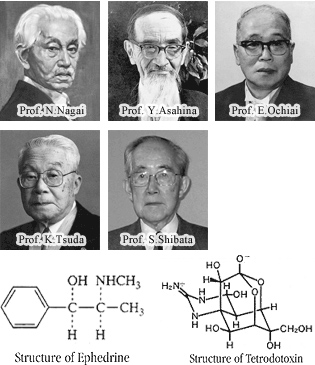Legendary Japanese Pharmaceutical Scholars
The Pharmaceutical Society of Japan (PSJ) must be more appropriately called as The Pharmaceutical Sciences Society of Japan. Since her inauguration in 1880, PSJ has grown to make great contributions to basic and applied pharmaceutical sciences and now has as many as 20,000 research-minded individual members. The research-oriented activities of PSJ has been inherited from legendary accomplishments by world-leading pharmaceutical pioneers throughout her 125 years history.
Historically, PSJ has been outstandingly strong at chemical studies (isolation, structure determination, or synthesis) of old herbal medicines or physiologically active natural products. The most famed scholars include Prof. Nagayoshi Nagai (Tokyo Univ.) who discovered ephedrine as the active ingredient of old medicine ephedra herb, against asthma as early as in 1885, Prof. Yasuhiko Asahina (Tokyo Univ. 1943 Order of Culture Awardee,the highest national honor) who studied components of traditional herbal medicines, Prof. Heizaburo Kondo (Tokyo Univ. 1958 Order of Culture Awardee), famous for the study of plant bases(alkaloids), Prof. Eiji Ochiai (Tokyo Univ. 1969 Order of Culture Awardee), pioneer of aromatic heterocyclic alkaloids, Prof. Kyosuke Tsuda (Tokyo Univ. 1982 Order of Culture Awardee) who isolated and determined the structure of fugu(puffer fish) poison, tetrodotoxin, and Prof. Shoji Shibata (Tokyo Univ. 1990 Person of Cultural Merits Awardee) for his study on fungal and lichen metabolites.

Recently, pharmaceutical researchers have been contributing to discovery of active trace substances in human bodies, as exemplified by Prof.Hisayuki Matsuo (Miyazaki Medical School. 1989 Japan Academy Prize) who isolated new natriuretic peptide hormones, and Prof. Michio Ui (Tokyo Univ. 1991 Japan Academy Prize) for role of GTP-binding proteins in coupling of receptors and adenylate cyclase. More recently, from among PSJ members a number of internationally renouned and landmark drugs have been created. They include Diltiazem (Dr. Nagao et al.Tanabe Seiyaku Co.,Ltd. 1988 The PSJ Award for Drug Research and Development(DRD) ) as Ca antagosist, Levofloxacin (Dr. Isao Hayakawa et al. Daiichi Pharm. Co.,Ltd.) as a quinolonecarboxylic acid antibacteria agent, Pravastatin ( Sankyo Co.,Ltd. 1991 The PSJ Award for DRD) as cholesterol-lowering drug, and Donepezil(Dr. Hachiro Sugimoto et al. Eizai Co.,Ltd. 1998 The PSJ Award for DRD) as anti-Alzheimer drug. Some of these drugs are described in the following pages.
In public health research area, Prof. Chunosin Ukita (Tokyo Univ. 1950 The PSJ Award) discovered in 1971 that methylmercury responsible for Minamata Disease is produced by action of methylcobalamine, Vitamin B12, on disposed inorganic Hg, and Prof. Zenzo Tamura (Tokyo Univ. 1979 The PSJ Award) identified in 1970 the cause of mysterious SMON desease to be a perscribed drug, Quinoform. The research activities are thus traditional and charateristic to PSJ. PSJ is now evolving to make greater commitments and contributions to broader spectra of pharmacy and healthcare in response to demands from society. However, our research-oriented culture and traditions shall always be maintained.

